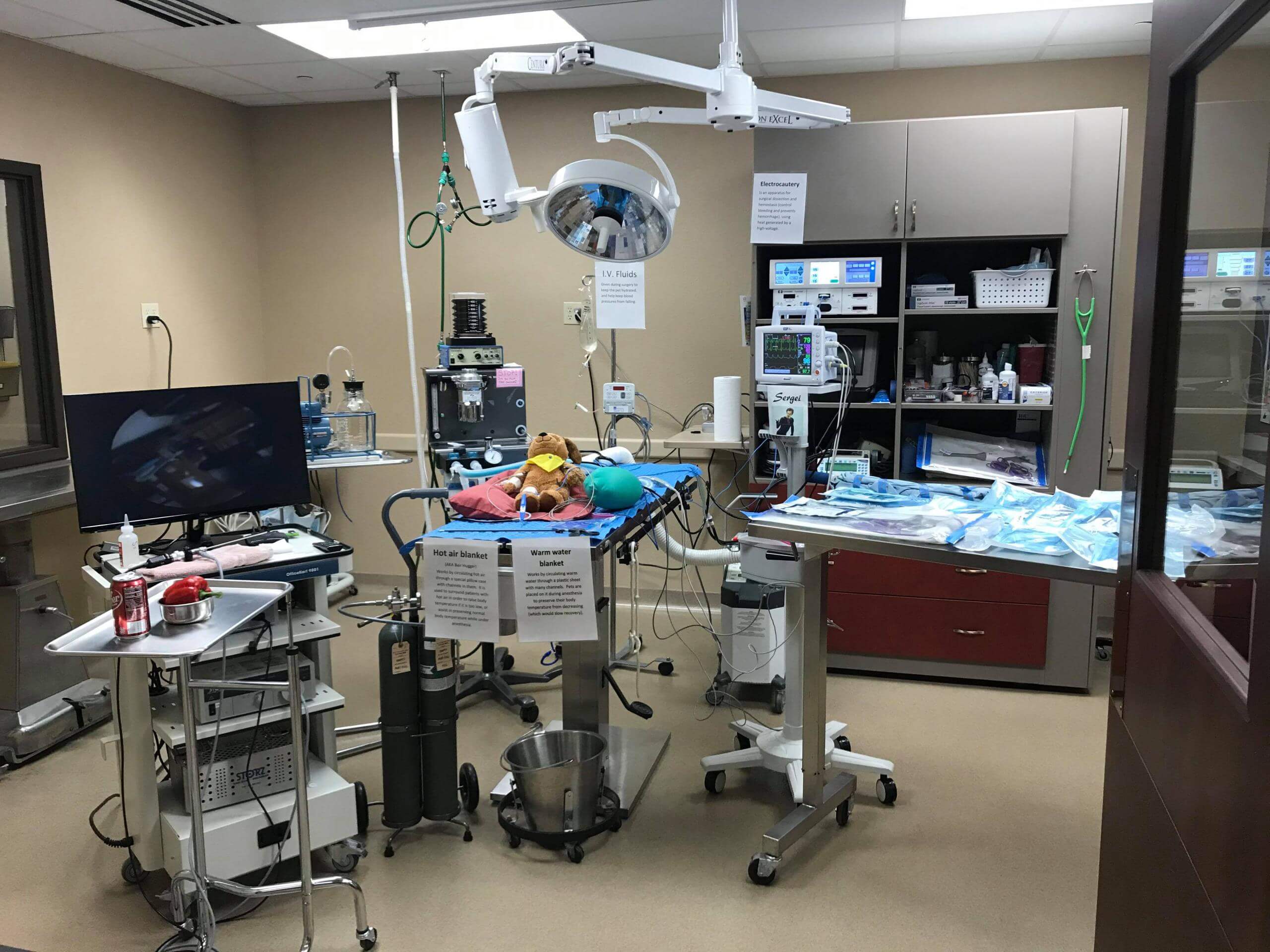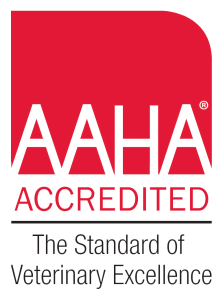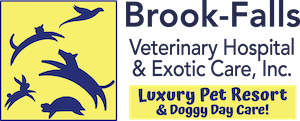The pandemic changed a lot – it has limited social interaction and it forced our hand at what we considered to be “normal”. Our clients were forced to limit their interactions with the veterinary staff and wait in their cars for their pets to be seen for their exams and procedures. While many ERs are still operating under curbside care, Brook-Falls is happy to have moved past that phase and continues to adopt new tools, knowledge, and procedures to serve both you and your pets. We currently have our doors open to our scheduled appointments but also offer curbside care and video exams for your pet. These are difficult times for our clients as well as our staff and veterinary services are in high demand. With many offices and emergency facilities, including Brook-Falls, being booked weeks in advance and have difficulty meeting the high demand, we are continuing to respond to these demands in new ways! We have implemented new scheduling procedures, added new personnel to meet client and patient needs and have new referral services available to help your pet and reduce wait times at referral and emergency centers. Brook-Falls looks forward to continuing to partner with you to care for your pets needs and will continue to adapt to meet the unique demands of our world, whatever may come!
The ER waits are long: We hear you
Many businesses are challenged with increased demand and fewer staff due to challenges that the pandemic has created, and Brook-Falls and the rest of the veterinary industry is no exception. Demand is high and both sick and well appointments are booked for weeks out. To combat this high demand, we have extended our business hours. Our office used to close promptly at 5PM every weeknight. We have since added personnel to our team to allow us to extend business hours until 7PM Monday – Thursday. We are pleased that this change has allowed us more flexibility in meeting our clients’ needs. Our hospital continues to be open on Fridays from 8-5 and Saturdays from 8-12. In addition to our veterinarians’ normal fully-booked schedules, anywhere from 18 – 26 appointments, our veterinarians also see at least two “drop-off appointments” AKA “flex appointments”, per doctor, per day. These appointments are in addition to our full schedule to make sure we meet your pets’ urgent needs. These appointments are reserved for urgent cases that need to be seen same day, but do not need to be seen this exact minute. We also reserve these appointments for clients and patients that have previously established care with Brook-Falls. Our client service team will still refer urgent cases to an emergency facility in the best interest of your pet if your pet requires immediate medical attention. Our doctors and staff often see these appointments over their lunch hours and work in between appointments to make sure that we can serve as many of our clients’ pets as possible. Please be patient, your pet will be triaged by a Certified Veterinary Technician (CVT) who will get approval for possible diagnostics for your pet. If the patient is in stable condition, they will be placed in an enclosure/incubator in an area where they can be monitored and seen when the doctor is available. Your pet will be seen, assessed and you will be contacted by a CVT or doctor as soon as the doctor is able to see your pet and evaluate their specific needs. We have specifically reserved appointment times for you, our clients, to make sure we have time to see your pets. While not every day are we able to see all pets that need care, we have made changes to make sure that we take care of you and your animals as our 1st priority. Please remember, that while it is top priority to see as many patients as we can, we will never compromise our standards of care to push ourselves to see too many patients. Each patient is important and deserves the same level of excellent care.
Long Waits to see a specialist at the referral center: We hear you
While the veterinarian shortage is real and veterinary specialists are difficult to see in a timely manner, we will continue to offer as many services as possible to care for your pet and keep them comfortable until you can receive specialist care. Additionally, we have partnered with some specialists to provide common referral care here at our hospital with board certified veterinarians to better care for your pet. We now offer Veterinary Ultrasound/Echocardiography at our clinic. We have invested in additional training for our staff and have purchased a new ultrasound machine to enhance our ability to find disease processes and allow us to provide additional services to our clients.
What is Ultrasound?
Ultrasound imaging uses sound waves to produce pictures of the inside of the body cavities. It helps to determine or localize the causes of pain, swelling and infection in the body's internal organs. It helps guide biopsies, diagnose heart conditions, look for bleeding, fluid accumulation and masses. Ultrasound is safe, noninvasive, and does not use radiation and is a minimally invasive way to quickly access your pet when an emergent or non-emergent situation is occurring. This procedure may involve mild sedation for your pet to get the best imaging and your pets affected area will be shaved to be able to image the area with greater detail. Your doctor will recommend this service to look for additional causes of your pet’s discomfort. Images maybe interpreted at our clinic or sent off for a board-certified specialist in radiology for review. Results are usually back in 24-72 hours after imaging. Providing information and starting diagnostics for your pet in an expedited manor.
What is Echocardiogram?
An echocardiogram (echo) is an ultrasound of the heart's movement and the movement of the fluid inside the heart. During an echo test, ultrasound (high-frequency sound waves) from a hand-held wand placed on your pets chest provides pictures of the heart's valves and chambers and helps the sonographer evaluate the pumping action of the heart. Echo along with Doppler ultrasound and color Doppler are used to evaluate blood flow across the heart's valves and look for causes of murmurs or heart disease. Doppler ultrasound is a special ultrasound technique that evaluates movement of fluids in the body. It allows the veterinarian to see and evaluate blood flow through arteries and veins in your pets’ heart and other organs. These results are sent off to a board-certified cardiologist to evaluate and tailor treatment for your pet. Results are usually back in 24-72 hours through this onsite referral service. We can often schedule one of these procedures in less than 1 week and have answers and a treatment plan for your pet in 7-10 days instead of waiting months.
In addition to ultrasound, we are now offering new surgical services with a Board-Certified Veterinary Surgeon: Dr Harpreet Singh DVM, DACVS-SA (Veterinary Surgical Services (VSS))
VSS is a surgery service designed to provide our clients with a highly skilled and Board-Certified Veterinary Surgeon, without the hassle of having to drive too far or placing your pet through unnecessary stress. Dr Singh works with Brook-Falls and performs needed referral surgeries here at the hospital and use a team approach to give your furry loved one the best care possible. He performs all soft tissue surgeries, all orthopedic surgeries (TPLO, patella repairs etc.…) and some neurosurgeries, depending on your pet’s needs and the level of care needed for your pet post operatively.
We are very excited to work with Dr Singh and be able to offer in house services that we have had to refer out before. We are hoping this will help us better care for your pets and have good continuity of care for your pet.
Looking for alternative treatments for your pet: We hear you
We have recently purchased a grade 4: Deep tissue therapeutic laser to offer alternative therapies for your pets.
Therapeutic lasers use light waves of a specific wavelength to cause photo-biomodulation, or the alteration of cellular and tissue physiology. Light absorbed by cellular components (specifically cytochrome C, a molecule which abounds in the mitochondria of the cells) stimulates electrons and activates cells to promote growth, proliferation, migration, and repair. They can be used in any process that causes inflammation.
Laser therapy helps tissue repair by stimulating:
- Endorphin release
- Vasodilation, which increases blood flow to bring in oxygen and cells involved in the healing process
- Decreased inflammation
- Muscle relaxation
- Faster repair and healing
The main clinical benefits of laser use in pets include decreased inflammation, decreased pain, and improved wound healing.
While we have been using therapeutic laser for our surgical patients for years to help reduce healing times and inflammation as well as for our patients with arthritis or orthopedic conditions. We have purchased the new laser which can penetrate deeper and offer additional treatments that were not available before with our previous laser.
Laser therapy is particularly useful for pets with limited medical treatment options, such as:
- Pets with liver or kidney disease who cannot take medications
- Cats and exotic pets, for whom only a few pain-control medications are approved, and for whom medication administration is difficult or impossible
- Geriatric with diminished organ function
The treatment session usually last 15 to 30 minutes, with the number of sessions and frequency of treatments dependent on the injury. Chronic conditions may be treated once to twice weekly, whereas surgical incisions and open wounds often require daily treatment.
The approach to pain and inflammation is multi modal, using as many tools as we can to help our patients and provide them with the best care and comfort due to an injury or when dealing with chronic pain and inflammation.
Looking for minimally invasive surgery with faster healing times: We hear you
We have over the last year added laparoscopic surgery, also known as keyhole surgery because of the minimally invasive scoping within the abdomen to our veterinary practice.

We now have 3 doctors that have undergone extensive training in these procedures and have learned new techniques to be able to serve your pets needs. We now offer this technique on Mondays, Wednesdays, and Fridays. While we continue to learn and use the tools we have. Our goal is to have all the doctors at Brook-falls trained in the use of this equipment and knowledgeable in these techniques to offer your pet the most up to date medical and surgical services possible.
Laparoscopic surgery is performed by making a small incision in the abdomen and inflating the abdomen with gas to allow for better visualization of the organs. This technique may involve one incision or two-three small incisions, the small incisions are used for inserting the laparoscope (camera) and surgical instruments and can vary depending on the procedure. The images are visualized on a large screen in the surgical suite and an overall image of the abdomen and organs can be evaluated for the procedure. When finished, the instruments are removed, and the small incisions are closed with sutures. This procedure is a great way to visualize organs and get an overall image of the abdomen without large incisions that take a longer time to heal. The average patient can return to normal activity in 3-5 days vs 10-14 days with typical large incisions for these procedures.
There are several surgical procedures that can be performed using laparoscopy. These include spays (ovariectomies (OVE)), retained-testicle neuters, intestinal foreign body removal, bladder stone removal, stomach tacking, and multiple organ biopsies.
For this technique for spays, we only remove the ovaries, and the uterus is left behind. This is different than a typical ovariohysterectomy (OVH) where the ovaries and the entire uterus is removed. When both ovaries are removed it is an ovariectomy surgery (OVE) versus when both ovaries AND the uterus are removed in a surgery it is an ovariohysterectomy (OVH).
Previously is has been common in the United States to perform ovariohysterectomies (OVH) but ovariectomies (OVE) are becoming more common in the recent years due to laparoscopy. In comparison OVE has been standard procedure in Europe for decades and is the common technique for spaying dogs and cats abroad. This information from abroad, has shown us that uterine diseases does not occur without hormones produced by the ovaries, except in the case of very rare cancers. A study of dogs found that 85-90% of these rare uterine tumors are benign, so the risk of developing a malignant uterine tumor following OVE estimates to be approximately 0.003% (Findji, Ovariohysterectomy vs Ovariectomy, Clinician’s Brief, March 2014).
OVE is thought to create less surgical trauma and require less tissue manipulation, which may lead to fewer complications than with a standard OVH. Incisions tend to be smaller (especially with laparoscopy), anesthesia is usually shorter in duration, and postoperative pain tends to be less. These are the reasons, ovariectomies are the recommended spay technique for pets with a healthy uterus at Brook-Falls and why we recommend laparoscopic surgery as the preferred technique for all dogs over 10lbs.
There are several advantages to this type of surgery. Smaller incision sites mean faster healing and less post-operative pain which reduces the recovery time. These procedures also tend to be faster than the alternative open abdominal surgery, which means less time under anesthesia for your pet. The smaller incision sites also mean that there is less exposure of abdominal organs to potential contaminants and decreased incidence of infection. Also, the use of the camera equipment increases the surgeon’s visibility of the abdomen and to find the affected area and sample the affected area or remove the affected tissue with great visualization that cannot be achieved during a normal open procedure.
WE HEAR YOU
Brook-Falls is a very progressive practice, and we want to make sure we have all the tools that we can to help our patients with the best care and offer all of the options and treatments we can to be able to treat our patients. We look forward to continuing to partner with you to provide the absolute best for your pets. If you have any questions about our new services, please feel free to contact us to learn more.


